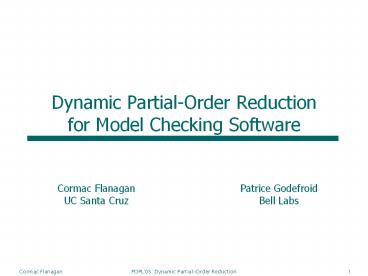Dynamic Partial-Order Reduction for Model Checking Software PowerPoint PPT Presentation
Title: Dynamic Partial-Order Reduction for Model Checking Software
1
Dynamic Partial-Order Reductionfor Model
Checking Software
- Cormac Flanagan
- UC Santa Cruz
Patrice Godefroid Bell Labs
2
Motivation
- Software model checking is prone to state
explosion - Two main causes
- input nondeterminism
- scheduling nondeterminism
- Example
- naive model checking n! interleavings, 2n
states - Partial-order reduction
- explores subset of the state space, without
sacrificing soundness
. . .
Thread 1 x1 1 stop
Thread n xn 1 stop
Thread 2 x2 1 stop
3
Independent transitions
s
- B and R are independent transitions if
- they commute B R R B
- neither enables nor disables the other
- Example x 3 and y 1 are independent
4
Persistent transitions
- B is a persistent transition if it is
independent with every transition R reachable
from S without executing B - If B is persistent then it is sound to only
explore B - Persistent sets - generalization to many threads
5
Static partial-order reduction
s
y 2
independent
z 3
static analysis
- Use static analysis to predict locations red
accesses after s - if static analysis proves that red thread only
accesses y and z - then x 1 is a persistent transition from s
6
Static partial-order reduction
s
q1 2
independent
q2 3
static analysis
- Use static analysis to predict locations red
accesses after s - Pointers?
- coarse analysis information gt limited POR gt
state explosion
7
Example static partial-order reduction
Global Vars lock m int t1,t2 int x0 int
n100 char a
Thread 2 lock(m) t2 x unlock(m) for(
t2ltn t22) at2 r
Thread 1 lock(m) t1 x unlock(m)
for( t1ltn t12) at1 b
- Static analysis gives
- t1, t2 are thread-local
- x is protected by m
- but at1 and at2 may alias
never alias (in practice)
- Static POR gives O(n2) explored states and
transitions - but only two possible terminating states
8
Dynamic partial-order reduction
- Static POR relies on static analysis
- to yield approximate information about run-time
behavior - pointers gt coarse information gt limited POR gt
state explosion - Dynamic POR
- while model checker explores the programs state
space, - it sees exactly which threads access which
locations - use to simulaneously reduce the state space while
model-checking - We present a solution for
- safety properties (deadlocks, assertion
violations, etc.) - acyclic state spaces
9
Dynamic partial-order reduction
backtrack set
(0x2FC3) 3
s
precise dynamic analysis
(0x1DA7) 7
exit()
- Execute initial arbitrary execution trace to
completion - Examine transitions performed by each thread
- identify and explore other interleavings that may
behave differently - dynamic alias analysis is easy
10
Dynamic partial-order reduction
backtrack set
backtrack set red
(0x2FC3) 3
s
precise dynamic analysis
(0x2FC3) 7
- Execute initial arbitrary execution trace to
completion - Examine transitions performed by each thread
- identify and explore other interleavings that may
behave differently - dynamic alias analysis is trivial
11
Dynamic partial-order reduction example
Initial trace
Thread 1 lock(m) t1 x unlock(m)
for( t1ltn t12) at1 b
Thread 2 lock(m) t2 x unlock(m)
for( t2ltn t22) at2 r
12
Dynamic partial-order reduction example
Initial trace
- Happens-before relation
- transitive closure of dependency relation
- represent using clock vectors
- DPOR Algorithm
- For each transition R of red thread, add a
backtracking point for red before last transition
B such that - B is dependent with R
- B does not happen-before R
- B is co-enabled with R
13
Dynamic partial-order reduction example
Initial trace
backtrack on red before lock(m)
lock(m)
lock(m)
t1 x
unlock(m)
a0b
not co-enabled
a2b
lock(m)
t1 x happens-before red gets here
t2 x
unlock(m)
a1r
no (dynamic) conflicts on a gt good POR
a3r
14
Dynamic partial-order reduction algorithm
- Dynamic POR algorithm for
- safety properties (deadlocks, assertion
violations, etc.) - acyclic state spaces
- Dynamically computes a persistent set in each
explored state - compatible and complementary with sleep sets
- Complexity O(m2.r)
- m number of threads
- r size of reduced state space
- some assumptions on dependence relation
15
Evaluation
- Two (small) benchmarks
- Indexer benchmark
- threads insert messages into shared hash table
- static analysis cannot predict absence of hash
table collisions - all hash table operations are dependent
- Filesystem benchmark
- synchronization idiom from Frangipani
- threads allocate shared disk blocks to inodes
- Ten model checking configurations
- no POR vs. static POR vs.
dynamic POR (stateless) - sleep sets vs. no sleep sets
- stateful search vs. stateless search
16
Indexer Benchmark
17
Filesystem Benchmark
18
Summary
- Dynamic partial-order reduction
- tackles state explosion due to scheduling
nondeterminism - no approximate/expensive/complicated static
analysis - supports pointer-rich data structures
- supports dynamic creation of threads/object/channe
ls etc - compatible and complementary with sleep sets
- Future work
- stateful DPOR, handling cycles
- liveness properties and full temporal logic
- incorporate into industrial-strength model
checker for multithreaded software (POSIX
threads, Java, C ?)
19
Dynamic Partial-Order Reductionfor Model
Checking Software
- Cormac Flanagan
- UC Santa Cruz
Patrice Godefroid Bell Labs

